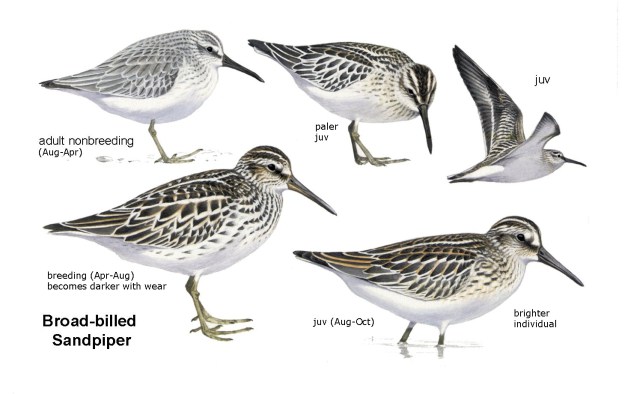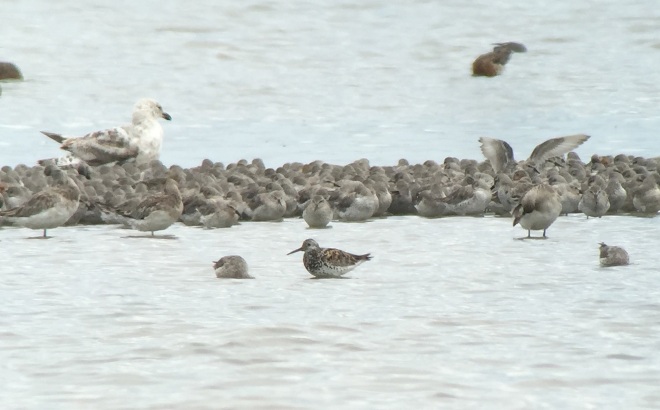Having reached the familiar state again this week of just needing to go somewhere, the arrival of a rare and attractive Asiatic wader in Norfolk provided a suitable reason to hit the road. With my limited June insect agenda for this year looking like being washed out, I slipped back firmly into birding mode with a lifer and two British list additions to go after around eastern England.
Two days ago only the fifth Great Knot for Britain had been found at Titchwell Marsh RSPB reserve on the north Norfolk coast. Despite its name this north-east Siberian breeder is only slightly bigger than regular Knot, but is quite distinctive in summer plumage. Having checked the species out in my Helm world shorebirds guide I decided it was a must see.
After staying overnight with friends in Suffolk I got to Titchwell at 9:30am. The first sighting had been posted on RBA at 6am and the car park was full. Not a good day for the RSPB then with all these green clad, optics wielding invaders likely to frighten those of the charity’s preferred clientele who might have managed to squeeze their way in. The visitor centre was in any case closed so I trod the path that skirts the “home for nature” and its “bug hotels” out to the action on the beach.
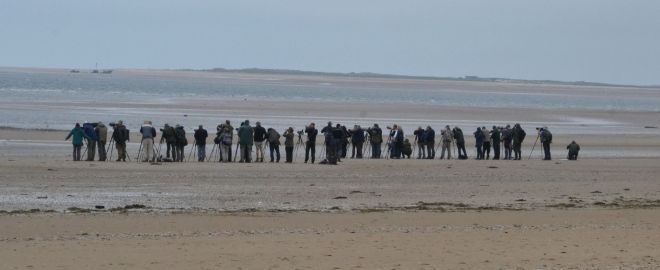
“Something about?”
I felt a little concerned at the number of birders walking back, but on reaching the beach there were still plenty scanning the shoreline (pictured above). Before me was what I had expected, a large flock of feeding Knot and other common waders. I decided the vagrant, though an adult in summer plumage was not a bird to self find and so acted dumb until a knowledgeable and helpful birder put me onto it. The Great Knot stood out clearly at distance due to it’s dark breast and belly spotting when seen head on, but was more difficult to identify when lost amongst the throng. This picture (below) shows the plumage detail and longer bill.
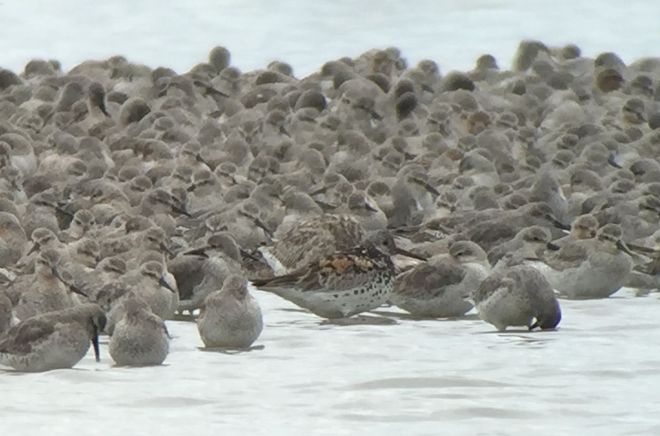
Great Knot (foreground, centre) © Andrew Last
The opportunity to observe summer plumaged red Knot for the first time was also part of the attraction of coming here. Every so often the waders would take flight and relocate, and so the searching would begin all over again. But with more birds in mind today I couldn’t stay for too long and so left a little reluctantly as the crowd dwindled. The entire flock apparently flew east shortly after I moved on late morning. The Great Knot wasn’t seen through the afternoon before being relocated eventually on Scolt Head Island. So my luck had been in.
I now headed for Lincs Wildlife Trust’s Gibraltar Point NNR, an area of sand dunes, salt marshes and fresh water habitats just south of Skegness that often features on RBA. Here two Caspian Tern were viewable from the hides. Being one of my favourite Algarve birds where there is a small wintering population, adding this Baltic breeder to my British list now appealed. The 77 mile drive around three sides of The Wash was arduous to say the least, with low speed limits along much of the route and a lot of farm traffic. Hence I didn’t arrive on site till 2pm.
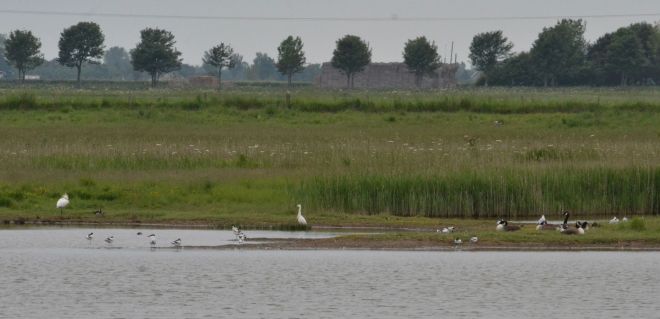
View over Tennyson’s Sands from Harvey’s Hide
The adult Caspian Tern were pointed out as soon as I entered one of the hides. Both birds seemed to favour standing with their backs to the audience, turning their heads from side to side. But these large terns always stand out at distance due to their big red bills, as the above and below left pictures show. The CT is amongst some Avocet at the left hand end of the group (above), giving a good indication as to just how big the visitors are. This was also very apparent when on occasion the birds took to the air (below right).

Caspian Tern

Caspian tern (lowest bird)

Caspian Tern (furthest right)
My late arrival here ruled out going on for the day’s third target, the long staying Great Reed Warbler near St Neot’s in Cambs. So I stayed at Gibraltar Point for a couple of hours, pleased to be out of the car and birding. There was also a Spoonbill at this site, always a good bird to see in England. Then the tedious 3½ hour journey back to Oxford beckoned and I left at 4pm, pleased to have increased my British bird list to a still very modest 319.
Foul Weather Footnotes
The present unsettled weather pattern has been excellent for re-organising and re-planting my wildlife garden a little later in the season than would normally be ideal. This is the time of year when adult Scarlet Tiger moths (pictured below) begin to fly around my park home. And that is one of those events in the wildlife calendar that gladden my heart.

Scarlet Tiger on Meadow Rue

Male Scarlet Tiger

… and long may it continue
I now feel relieved at having gone to France in mid-May because the June weather there has by all accounts been as unfriendly to butterflies as at home. But if this grey and wet scenario continues, as seems likely I do foresee certain benefits to counter any boredom. One is that the annual bun fight surrounding Black Hairstreak butterflies at those sites where they occur in Oxon and Bucks may hopefully not happen this year.
Then this rare and precious resource could be left to procreate in peace as they will do whatever the weather, and despite what conservation charities might say in fund raising literature. If Black Hairstreak were a bird, secrecy as to their whereabouts would protect sensitive breeding status. Instead it is open season each year on these butterflies and their habitat, and I for one would like to see that situation alter for the better.
The second potential plus point could be nice areas of surface water locally for the late summer bird migration season. There was an exceptional spring wader passage through God’s own county (Oxon) this year, but I missed some of the highlights through being in France. As a result I am at present some way behind the leading county listers in 2016, not that I view things competitively of course. Experiencing such an exceptional bird as Great Knot this week has served to whet my appetite for the return passage both locally and nationally.
